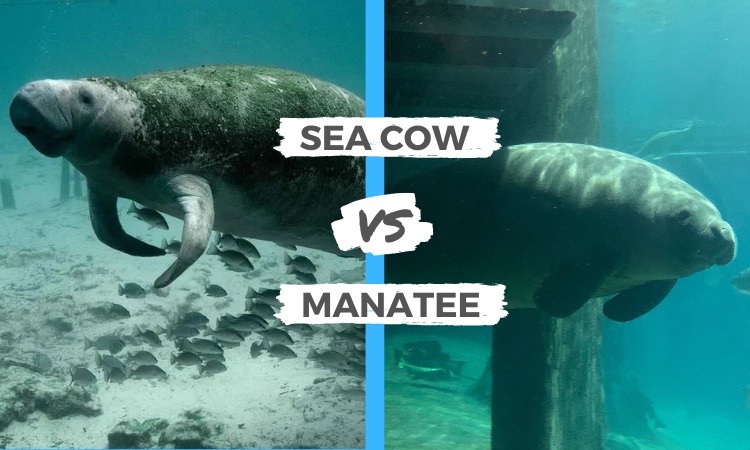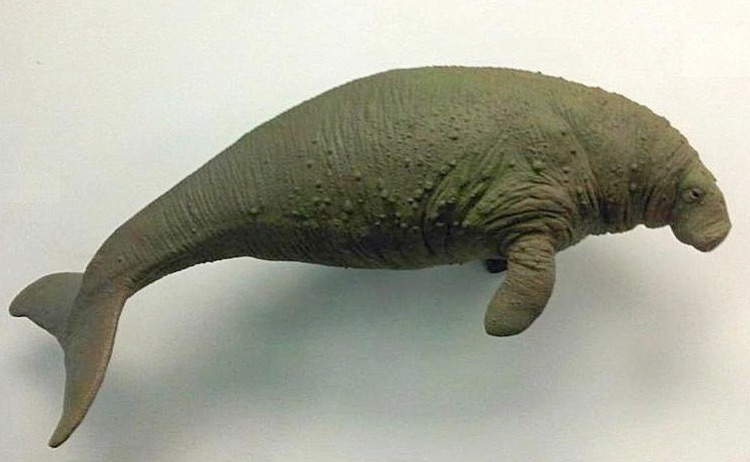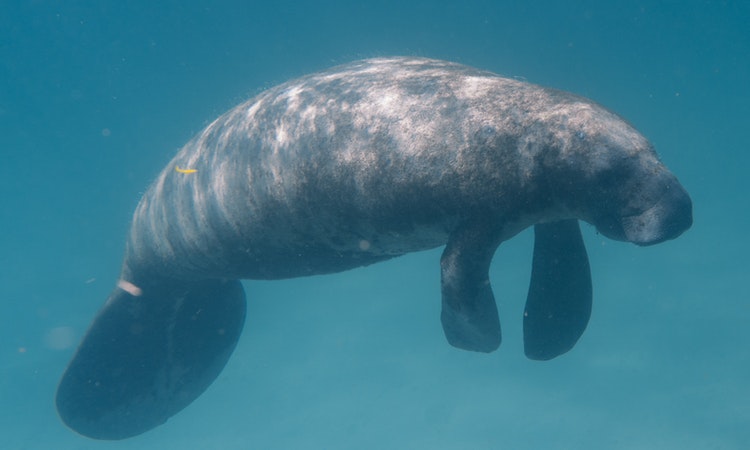The sea cow and manatee are both huge marine animals with small heads that eat seagrass as their major food source.
Sea cows and manatees as terms can be used interchangeably. For this article we are going to compare Steller’s sea cow vs manatee. Although there are some distinctions between the species, many aspects of their existence are comparable.

Sea Cow vs Manatee: Differences and Similarities
The sea cow and the manatee are distinct species. However, they also share many similarities with each other.
Size: The maximum length of a sea cow is 9m, comparable to that of manatees.
Appearance: Both the sea cow and the manatee have a thick blubber skin, a small head-to-body proportion, and a big dorsal single fin.
Diet: Manatees are fussy eaters, eating mostly sea grass, whereas sea cows consume a greater variety of freshwater and saltwater plants.
Habitat: Both manatees and sea cows live in shallow waters. However, manatees live in both salt and fresh water where as sea cows live only in salt water
Buoyancy: When compared to the manatee, sea cows are naturally buoyant and find it difficult to dive down.
Sea Cow
Let us look at the sea cow in more detail. Firstly, here are some fun facts:
- The sea cow ate seagrass.
- In the 18th century, the sea cow became extinct.
- It didn’t have teeth
- In comparison to its body, the sea cow’s head was quite tiny.
What is a Sea Cow?
The Steller’s sea cow was a member of the Dugongidae family, along with the Pygmy right whale. It was known as the Commander Sea Cow. This was because it lived in the Bering Sea and around the Commander Islands. In 1741, Georg Wilhelm Steller initially described it in his book “On the Beasts of the Sea”.
Is the Sea Cow Extinct?
Yes, the Steller’s sea cow is no longer with us. It went extinct in the 18th century. Only a few years after it was formally discovered, the animal was hunted to extinction due to high demand for its fat and meat.

Sea Cow Appearance
The sea cow was a huge creature that grew to be around thirty feet long, or nine meters. One skull estimated at ten feet in length was discovered in 1987. Other complete skeletons have been found as large as seventeen to twenty or more feet.
The snout of this aquatic mammal was turned downward, similar to that of manatees and dugongs, making it easier to feed on sea grass underwater.
The Steller sea cow had a thick outer shell, about 1 inch thick, which shielded it from sharp rocks and ice as it foraged for food. The sea cow had three to four inches of thick blubber. This allowed it to flourish in the frigid seas where it was indigenous.
They were dark brown in color, with white spots on some of them. The skin had a rough texture that scientists now believe was caused by parasites digging into the skin and creating depressions.
The sea cow had a tiny head in comparison to its body; something dugongs and manatees still exhibit today. They also had enormous upper lips that extended beyond the lower jaw.
Where did Sea Cows Live?
The sea cow inhabited the shallow waters around Commander Islands (including the Bering and Cooper Islands) in the Bering Sea at the time of its discovery. Earlier fossils have been found around Monterey Bay, California, and on Honshu, Japan.
Reproductive Habits
Females of this species had only one set of mammary glands, according to Steller, who studied sea cows. This prompted him to decide that these creatures gave birth to only one calf every year. In early spring, the pair was supposed to mate. Unfortunately, because these animals went extinct in the 18th century, little is known about their mating customs.
What Did Sea Cows Eat?
The sea cow, like manatees and dugongs, ate seaweed. The Steller’s sea cow was toothless as well. The sea cow had interlacing bristles instead of teeth.
The manatee was highly buoyant, whereas the sea cow was extremely floaty. This suggests that it could not entirely submerge itself. It is distinct from dugongs and manatees among other sirenians due to this.
Manatee
Let us look at the manatee in more detail. Firstly, here are some fun facts:
- Large vessels due to their loud noises will often collide with manatees owing to their threat of extinction.
- Manatees are plant-eaters.
- Manatees weigh about 66 pounds when they’re born.
- Manatees have long been associated with mermaid folklore.
- Shallow, coastal regions are more appealing to them.
What is a Manatee?
Manatees are extremely large herbivores that are sometimes referred to as sea cows, although they are a distinct species. The dugong is the only surviving member of the order Sirenia, with three species and three of the four living types.
The three manatee species are:
- Amazonian manatee or (Trichechus inunguis)
- West African manatee or (Trichechus senegalensis)
- West Indian manatee or (Trichechus manatus)
Manatees have long been associated with mermaid mythology. They’ve been revered in some societies, such as West Africa, where they were regarded sacred and even believed to be human in the past.
Manatee Appearance
These are enormous animals, similar to the sea cow. They reach lengths of about thirteen feet and weigh up to 1,300 pounds. Manatees have paddle-shaped flippers like dugongs and sea cows do.
The manatee’s tail is the most obvious trait. The sea cow’s tail is fluked like a whale’s (or a dugong’s), whereas the manatee’s tail is paddle-shaped.
The manatee’s neck is also unusual. It has just six cervical vertebrae, whereas every other mammal has seven. That is, except for two types of sloths. Manatees have teeth as well, in contrast to sea cows with white bristles.
Where Do Manatees Live?
They prefer to dwell in shallow, coastal regions. However, their range is greater than that of the sea cow. They may be found throughout the Amazon basin, the Gulf of Mexico, and West Africa, among other places.
The three species of manatee are most easily distinguished by their habitat, such as the Amazon basin or West Africa’s coastline. Manatees are a migratory species as well. In Florida in winter, they reside near the coast.

Reproductive Habits
A newborn manatee weighs 66 pounds or 30 kg. They breed every two years, and a single calf is produced, much like the dugong and sea cow.
Manatees reach sexual maturity at around five years of age. Manatees may go through a two-year waiting period before giving birth if they lose a calf.
What Do Manatees Eat?
Manatees are herbivores like Steller’s sea cow. They consume about 60 different freshwater and saltwater plants. Turtle grass, sea clover, marine algae, and shoal grass are some of the plants that they enjoy.
Sea Cow vs Manatee: Threats
Unfortunately, hunters exterminated the sea cow in the 18th century. As a result, they cannot be studied because they no longer exist.
They are at risk from human encroachment on critical habitats, pollution, and climate change. Crocodiles, for example, pose a major hazard to both manatee (and dugong) calves.
The word “manatee” comes from the old Spanish term for “water cow.” Manatees are slow-moving swimmers. This tells us that boat collisions are a major cause of their deaths and injuries.
Manatees have scars from collisions with boats, such as propeller-driven vessels and ships. If the initial collision fails to kill the manatee, subsequent infection is a possibility.
Many vessels also radiate low frequencies that confound manatees. This why boats often collide with them.
The dugong is currently the only surviving member of the Dugongidae family, with the Steller’s sea cow being its closest living relative.


